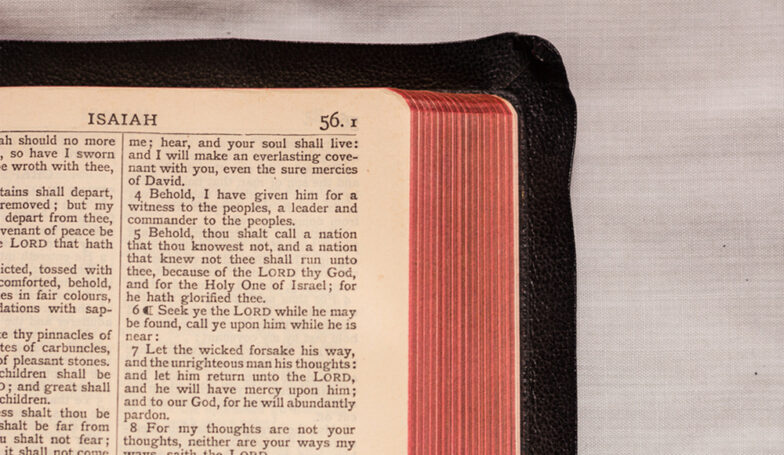From Noah to Abraham to Moses: Evidence of Genealogical Gaps in Mosaic Literature, Part 3
We continue this series on gaps in Scripture’s genealogical records by looking at the legacy of Noah and his sons. In particular, this story introduces a hermeneutical problem that arises because of the way date-setters (those who attempt to calculate a creation date based on biblical genealogies) interpret a key Hebrew word.
As demonstrated in part 2 of this series, the story of Moses supports the idea of gaps in biblical genealogies. In particular, it shows that the Hebrew word yālad (usually translated “begat” in KJV or “became the father of” in NIV, NASB) does not necessarily imply a parent-child relationship; it can also refer to a more general familial connection. This discovery topples the central assumption of those who attempt to calculate an exact creation date using biblical genealogies. In this article, we will discuss how the assumption that yālad always means “begat” or “became the father of” presents a critical hermeneutical problem.
The stories of Noah’s three sons and of Abraham (discussed in part 4) illustrate the hermeneutical problem. Consider Genesis 5:32 and 11:26 (NKJV):
“And Noah was five hundred years old, and Noah begot [yālad] Shem, Ham, and Japheth.” (Genesis 5:32)
“Now Terah lived seventy years, and begot [yālad] Abram [Abraham], Nahor, and Haran.” (Genesis 11:26)
If scholars who attempt to calculate a precise biblical timeline apply the same interpretation of yālad to these verses as they do to Genesis 5, 10, and 11 and other genealogy passages, the only consistent, literal conclusion is that Noah’s sons Shem, Ham, and Japheth were triplets, as were Abraham, Nahor, and Haran. Yet few (if any) scholars suggest these men were triplets. In other words, they interpret yālad in Genesis 5:32 and 11:26 differently than in the rest of the genealogy passages in which it occurs; their hermeneutics is inconsistent.
So why are these patriarchs rarely thought of as triplets? The answer surely must be context and narrative. For example, the birth of twins among the patriarchs is greeted with celebration and a birth narrative. Triplets are thirty times more unusual than twins, but neither Genesis 5:32 nor 11:26 includes a narrative about the birth of triplets—a noteworthy omission. Moreover, with so relatively few patriarchs named in the Bible, it is improbable that there could be two sets of triplets.
Shem, Ham, and Japheth
The Flood narrative seems to make it clear that Noah’s sons Shem, Ham, and Japheth were not triplets:
“Now Noah was six hundred years old when the flood of water came upon the earth” (Genesis 7:6, NASB).
“…Shem was one hundred years old, and begot Arphaxad two years after the flood” (Genesis 11:10b, NKJV).
“When Noah awoke from his wine, he knew what his youngest son [Ham] had done to him” (Genesis 9:24, NASB; or “younger son” [NKJV]).
These verses not only show that the three are nottriplets, they also provide evidence that Genesis 5:32 does not list the three in birth order:
- Shem is 100 years old two years after the flood, when Noah is 602 years old (counted from the beginning of the flood, or 603 years old counted from the end of the flood). Hence, Shem was born when Noah was 502 (or 503) years old, not 500 years old.
- Ham is a younger (perhaps the youngest) son.
- Since Genesis 5:32 says Noah “begot” when he was 500 years old, Japheth must have been the son born at that time, making him the oldest.
Japheth is Oldest
Genesis 10:21 seems to confirm that Japheth is the oldest, though some modern English translations disagree. In Hebrew this verse states that Shem is the ׳āh (“brother or male relative”) of Japheth the gādôl (“great”). All modern English Bibles translate gādôl as meaning “elder brother,” but they disagree on the antecedent. The JPS, NASB, ESV, and RSV translate the verse to say Shem is the older brother. By contrast, the NIV and AMP say Japheth is the older, and the LXX, KJV, NKJV, and YLT read “Japheth the elder.”
This disparity in the English translations reflects the ambiguity of biblical Hebrew. It seems impossible to determine precisely which brother is older. Nevertheless, the Greek in the Septuagint (LXX) clearly states that Japheth is older sibling. Considering the above comparison of Genesis 7:6, 9:24, and 11:10, it seems probable the LXX—often believed to reflect Jewish tradition in the third century BC—is clarifying the ambiguity of the biblical Hebrew in Genesis 10:21. Hence, we believe translations that list Shem as the oldest do so only because he is listed first in Genesis 5:32.
As further support of Japheth’s primacy, the genealogy in 1 Chronicles 1 lists Japheth’s offspring first (1 Chronicles 1:5–7), Ham’s second (1 Chronicles 1:8–16), and Shem’s last (1 Chronicles 1:17–27). Josephus describes Shem as “the third son of Noah”; and Bishop James Ussher—whose seventeenth century creation chronology continues to influence young-earth creationist views—lists Japheth as oldest, and Shem as second son.
So if Shem is not the oldest, why is he listed first in Genesis 5:32? We suspect the list is in the order of relative importance to the ancient Israelites:
- Shem is ancestor of the Jewish race and, therefore, the most important.
- Ham is ancestor of the Egyptians and Canaanites, who enslaved the Israelites and were their continual adversaries.
- Japheth, as ancestor of northern peoples who had relatively little contact with the Israelites at the time the Old Testament was written, was least important to the Israelites.
Another interpretation is that Shem is listed first because his father declared that he would receive the oldest son’s share of the inheritance, even though he was not the oldest. An example of this occurs in the story of Jacob: Joseph is given primacy over his older brother Reuben, and Jacob gives the oldest son’s blessing to Joseph’s younger son Ephraim.
Part 4 of this series uses the story of Abraham to further illustrate the hermeneutical problems ignored by biblical date-setters. We will also show how flexibility in biblical Hebrew’s familial terms enhances the likelihood that there are unrecognized gaps in the biblical genealogical records.

Dr. Hugh Henry received his PhD in Physics from the University of Virginia in 1971, retired after 26 years at Varian Medical Systems, and currently serves as a lecturer in physics at Northern Kentucky University in Highland Heights, KY.

Mr. Daniel J. Dyke received his Master of Theology from Princeton Theological Seminary 1981 and currently serves as professor of Old Testament at Cincinnati Christian University in Cincinnati, OH.
Part 1 | Part 2 | Part 3 | Part 4 | Part 5
Endnotes
- cf Genesis 25:24–26, 38:27–30.
- For instance, prior to the advent of modern fertility treatments around 1980, in the United States twins occurred in roughly 3 out of 1,000 births (3 percent), and triplets in less than 1 out of 1,000 births (0.1 percent); see HYPERLINK “https://www.marchofdimes.com/pregnancy/trying_multiples.html” https://www.marchofdimes.com/pregnancy/trying_multiples.html. There seems no reason to assume the frequency of multiple births among the ancients was greater than this.
- “Shem . . . the elder (or older) brother of Japheth . . .” ( Genesis 10:21, JPS, ESV, NASB, RSV).
- “Shem, whose older brother was Japheth” (Genesis 10:21, NIV); “Shem . . . , the younger brother of Japheth” (Genesis 10:21, AMP).
- καὶ τῷ Σημ ἐγενήθη καὶ αὐτῷ πατρὶ πάντων τῶν υἱῶν Εβερ ἀδελφῷ Ιαφεθ τοῦ μείζονος (Genesis 10:21, BGT). The Greek adjective is without question linked to Japheth, not Shem, confirming Japheth is older sibling.
- William Whiston, trans., The Works of Josephus, “The Antiquities of the Jews” 6, no. 4 (Peabody, MA: Hendrickson, 1987), 37.
- James Ussher, The Annals of the World (Green Forest, AR: Master Books, 2003), 19. cf Genesis 48.






